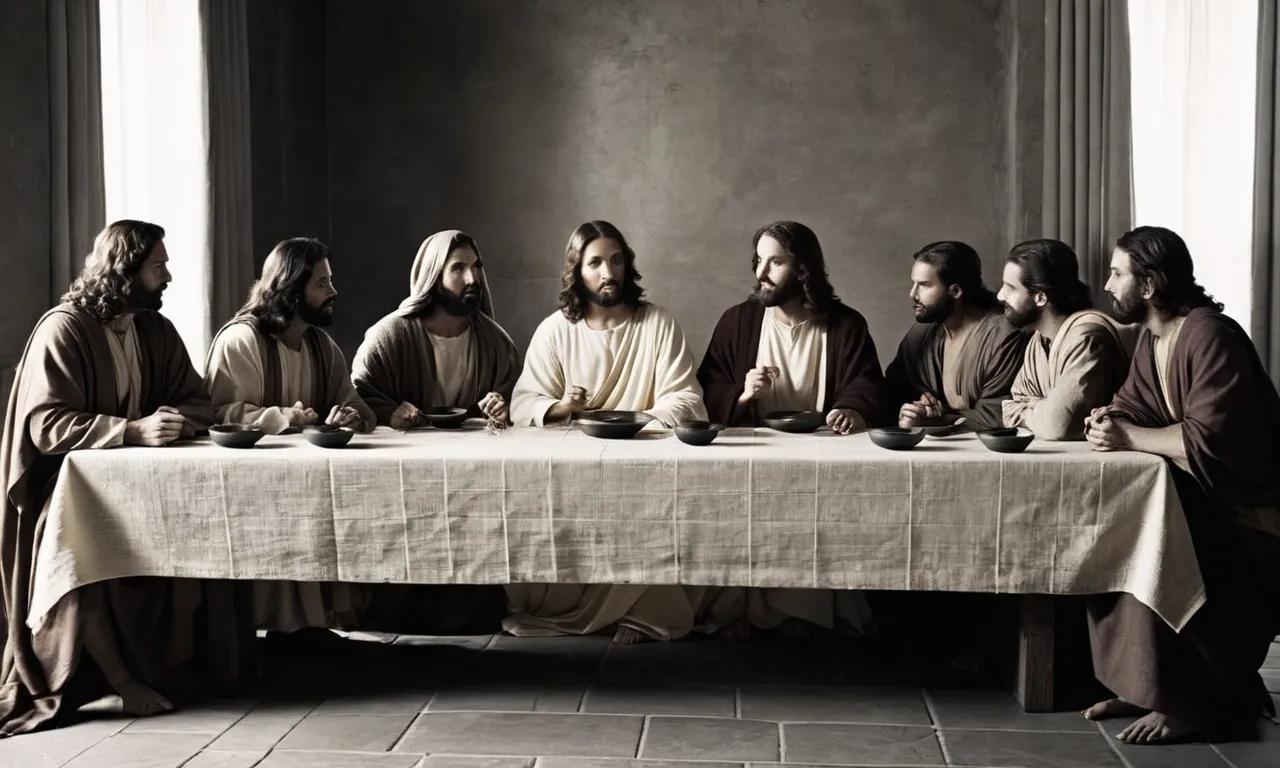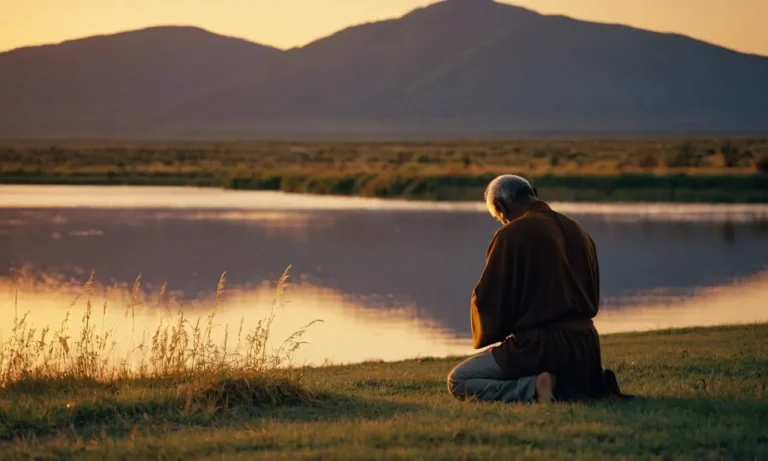Who Was At The Last Supper With Jesus?
The Last Supper is one of the most iconic events in Christianity, as Jesus gathered his 12 disciples together for a final meal before his crucifixion. But who exactly joined Jesus at this monumental supper?
If you’re short on time, here’s a quick answer: Jesus was joined by his 12 disciples at the Last Supper – Peter, Andrew, James, John, Philip, Bartholomew, Matthew, Thomas, James son of Alphaeus, Simon the Zealot, Jude Thaddaeus, and Judas Iscariot.
In this comprehensive article, we will dive deep into exploring the identities of Jesus’ disciples at the Last Supper, examining details about each one and why they were chosen by Jesus.
We will also analyze the significance of this supper and the words Jesus left with his disciples there, which have impacted Christianity for over 2,000 years.
Jesus Gathered his 12 Disciples for the Last Supper
The 12 Disciples of Jesus
Jesus chose 12 disciples to be his closest followers and supporters during his ministry on earth. These 12 men played a vital role in spreading Jesus’ teachings and carrying on his work after his death and resurrection. Here are the names of the 12 disciples:
- Simon Peter
- Andrew, Simon Peter’s brother
- James, son of Zebedee
- John, James’ brother
- Philip
- Bartholomew
- Thomas
- Matthew, the tax collector
- James, son of Alphaeus
- Thaddaeus
- Simon the Zealot
- Judas Iscariot
This inner circle of 12 was with Jesus throughout his ministry. They witnessed Jesus’ miracles and heard his teachings firsthand. Peter, James, John and Andrew in particular had a very close relationship with Jesus.
Why These 12 Were Chosen
Jesus chose ordinary men from humble backgrounds to be his disciples. They were not scholars or religious leaders. However, Jesus saw great potential in them.
Here are some reasons Jesus may have chosen these 12:
- They were willing to learn and follow him. Jesus valued faith and obedience over expertise.
- He wanted common men who could relate to ordinary people.
- They would give an eyewitness testimony after his resurrection.
- Twelve disciples mirrored the 12 tribes of Israel, showing Jesus as the fulfillment of God’s promises.
- The number 12 is symbolic of authority and power.
Despite their faults and failures, these 12 men humbly followed Jesus. After receiving the Holy Spirit at Pentecost, they boldly spread the gospel and led the early church.
Their changed lives after encountering Jesus testified to the authenticity of his ministry.
While we don’t know the exact reason Jesus chose these 12, we do know he can use imperfect people in powerful ways when they submit their lives to him. The 12 disciples are an encouraging example of ordinary people being used by God for extraordinary purposes.
A Closer Look at Each of the 12 Disciples at the Last Supper
Simon Peter
Simon Peter, often just called Peter, was one of Jesus’ closest disciples. He was a fisherman before becoming a follower of Christ.
Peter was present at many key events in Jesus’ ministry, including the Transfiguration and the raising of Jairus’ daughter.
At the Last Supper, Peter boldly declared that even if all the other disciples abandoned Jesus, he would not (Matthew 26:33). However, Peter later denied knowing Jesus three times when Jesus was arrested. After the resurrection, Peter went on to become a pillar of the early church in Jerusalem.
Andrew, Brother of Peter
Andrew was Simon Peter’s brother and also a fisherman before following Jesus. He is often referred to as Simon Peter’s brother in the Gospels.
Andrew was one of the first disciples called by Jesus. After Jesus’ ascension, Andrew went on to preach the gospel around the Black Sea and in Greece.
He is said to have been martyred by crucifixion in Patras, Greece.
James, Son of Zebedee
James was one of two sons of Zebedee who followed Jesus. He and his brother John were known as the “Sons of Thunder.”
James was part of Jesus’ innermost circle along with Peter and John. He witnessed the Transfiguration as well as other key events.
According to tradition, James was later martyred by King Herod Agrippa I shortly after Jesus’ death (Acts 12:2). He is often referred to as James the Greater to distinguish him from the other apostle named James.
John, Brother of James and Son of Zebedee
John was the younger brother of James and the son of Zebedee. Along with Peter and James, he was one of Jesus’ closest confidants.
John is traditionally regarded as the author of the Gospel of John, three epistles in the New Testament, and the Book of Revelation.
He outlived the other disciples and is believed to have lived until around 100 AD in Ephesus. John emphasized love as central to the gospel message more than any other New Testament writer.
Philip
Philip was from Bethsaida, the same hometown as Peter and Andrew. He brought Nathanael to Jesus at the beginning of Jesus’ ministry.
Little else is known about Philip from the Gospels, but tradition holds that he preached the gospel in Greece and modern-day Turkey.
He is said to have been martyred by crucifixion in Hierapolis.
Bartholomew
Bartholomew is only mentioned in the synoptic Gospels’ lists of the Twelve. Many scholars believe he may be the same person as Nathanael in the Gospel of John.
Nathanael was brought to Jesus by Philip. If they are the same person, that would mean Bartholomew was also from Cana in Galilee.
Church tradition holds that Bartholomew preached in India, Armenia, and Ethiopia where he was martyred by flaying.

Matthew
Matthew, also called Levi, was a tax collector before becoming a disciple of Jesus. As a tax collector, Matthew would have been despised by many Jewish people.
Jesus’ calling of Matthew shows his willingness to reach out to despised members of society.
Matthew is traditionally regarded as the author of the Gospel of Matthew. Not much else is known about his life after the resurrection, but he is believed to have preached in Judea or modern-day Lebanon.
Thomas
Thomas is famously remembered as “Doubting Thomas” because he refused to believe Jesus had risen until he could see and touch the resurrected Christ.
While this earned him a negative reputation, Thomas’ honest skepticism led to one of the most dramatic encounters with the risen Jesus.
After seeing Jesus, Thomas proclaimed “My Lord and my God!” (John 20:28). Church tradition holds that Thomas later preached the gospel in Persia and India where he was martyred.
James, Son of Alphaeus
James, son of Alphaeus, is one of the more obscure disciples. He shares the name James with another disciple which has led to confusion between the two.
This James is sometimes called “James the Lesser” or “James the Less” to differentiate him.
Not much is known about him aside from being listed among the Twelve. Later traditions claim he preached and was martyred in Egypt.
Simon the Zealot
Simon was called the Zealot, likely because he belonged to a radical political party before following Jesus that was known for religious zeal and revolutionary acts.
Having a Zealot among Jesus’ inner circle shows his openness to those with diverse and even extreme backgrounds.
According to the historian Eusebius, Simon preached in Egypt and then joined Judas, son of James, in Persia where he was martyred.
Jude Thaddeus
Jude Thaddaeus is referred to as both Jude and Thaddaeus in lists of the twelve apostles. He is often called Jude to distinguish him from Judas Iscariot and Judas, son of James. Along with James, son of Alphaeus, he remains an obscure figure.
One of his few mentions in the Gospels is asking Jesus at the Last Supper why he chose to reveal himself to the disciples but not the world. Church tradition holds that he preached in Assyria and Persia where he was martyred.
Judas Iscariot
Judas Iscariot is infamous for betraying Jesus and handing him over to the religious leaders to be crucified. Judas was the treasurer among the disciples and dipped his hand into the money bag. At the Last Supper, Jesus predicted his betrayal.
After the meal, Judas led the temple guards to arrest Jesus in the Garden of Gethsemane. Overcome with guilt afterwards, Judas hanged himself. He is remembered as history’s most notorious traitor.
The Significance of the Last Supper for Christianity
Jesus’ Farewell Discourse to His Disciples
At the Last Supper, Jesus gave an extensive farewell discourse to his disciples (John 13–16). He reassured them of his loving care and told them that he would soon be returning to his Father.
These chapters in John’s Gospel record Jesus’ words of comfort, encouragement, and guidance for the difficult days ahead, including after his impending death.
They give Christians a window into Jesus’ final teachings before his ultimate sacrifice on the cross.
Institution of the Eucharist
During the Last Supper, Jesus instituted the sacrament of the Eucharist (Holy Communion, Lord’s Supper) (Matt. 26:26–28).
Taking bread and wine, he identified them with his body and blood, which would be given up for them. He commanded his followers to “do this in remembrance of me.
Prediction of Judas’ Betrayal
At the Last Supper, Jesus ominously told his disciples, “One of you will betray me” (Matt. 26:21). This is understood to refer to Judas Iscariot, who handed Jesus over to the Jewish authorities. The disciples had their loyalties tested, and Peter even denied Jesus.
But through it all, God’s sovereign plan was accomplished. And this example of treachery highlights the unlimited grace that Jesus extended to sinners, including his betrayer. Truly “amazing grace” was on display.
Conclusion
The Last Supper was a pivotal moment for Jesus to prepare his closest followers for his coming sacrifice and resurrection.
By gathering his 12 disciples – Peter, Andrew, James, John, Philip, Bartholomew, Matthew, Thomas, James son of Alphaeus, Simon the Zealot, Jude Thaddaeus, and Judas Iscariot – Jesus was able to teach, guide, and comfort them one final time before his death on the cross.
This supper also instituted central Christian practices like the Eucharist, while predicting Judas’ betrayal. Understanding who joined Jesus at that table more than 2,000 years ago provides insight into an event that shaped the faith we know today.







